Results

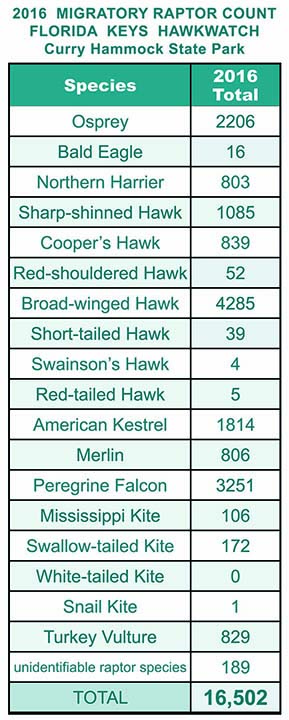
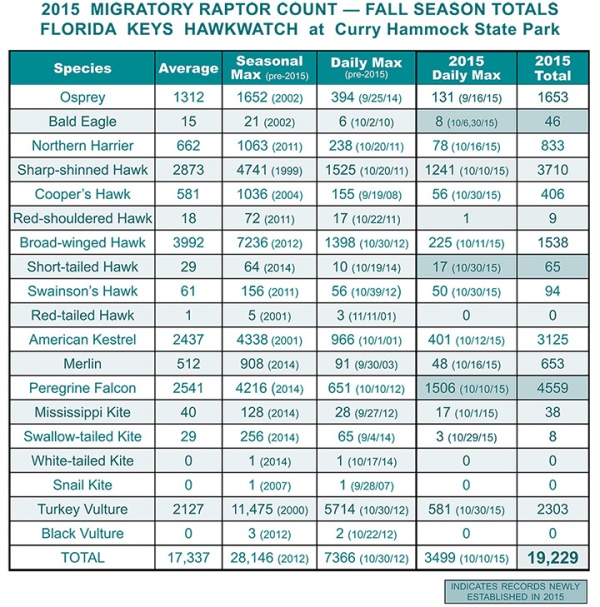
Hawkwatch Totals and Highlights for the Fall of 2012
During the 2012 fall season at FKH, counters focused on monitoring and documenting the passage of all detected birds of prey, which this season were 17 species. Included were eight primary migrant raptors as designated during the HWI years, and seven less common raptors. Most notable was the recommencement of the monitoring of Turkey Vulture flights over the site, a practice that had been ceased in the past because it presented tallying challenges.
The fall of 2012 was a memorable migration monitoring season because the total number of tallied raptors, 28,146 was higher than all seasons since 1999. The total raptor count was boosted by Turkey Vultures, a species that had not been monitored between 2001 and 2010. Excluding vultures, the 2012 count was also higher than all other FKH counts seasons, with 20,388.
Five species had higher seasonal totals this fall than all previous seasons, including Broad-winged Hawk, Peregrine Falcon, Mississippi Kite, Turkey Vulture and Black Vulture. However, it was the Peregrine Falcon once again that captured the most interest after breaking the single day world record at the site, with 651 counted on October 10, 2012, and by breaking the full-season record with 3,836, with more individuals of the species documented during an entire migration season than anywhere else on the planet.
Starting 2011, the project has standardized the documentation of all detected migratory birds species from the traditional CHSP count site and other locations in the Middle Keys area including Crane Point Hammock (2011) and Long Key State Park (2012). This effort was prompted by deficiencies in long-term data of migratory birds from the Florida Keys, particularly Nearctic-Neotropical songbirds. While birds of prey have been monitored in the Marathon area for nearly 20 years, there are no long-term studies on non-raptor migrants using the Keys as stopover sites during fall migration. Additionally, several habitat preserves in the region, including state parks and wildlife refuges, might not have accurate knowledge of the avian species using their sites during migration. FKH has been coordinating with land managers and will be providing a comprehensive list of species documented to help the parks and preserves enrich their profiles.
HIGHLIGHTS 2012
The following are some of the most notable flights from the 2012 fall season. These numbers include southbound counts only; detailed flight direction data exists for all monitored species in the FKH project database. An analysis of documented northbound movement of these species in relation to southbound flights is outside the scope of this report.
PEREGRINE FALCON: 3,836
This was the best season on record for Peregrine Falcon flights; the total of 3,836 birds marked the highest number ever tallied during migration anywhere in the world. This surpassed the 2,976 Peregrines tallied at FKH during the 2011 season. The daily max of 651 tallied on October 10 was also a world record, for the most observed during a single day. This surpassed the previous single-day record of 638, also established at this site on October 11, 2008. Top Peregrine Falcon flights for 2012 included:
651 — 10 Oct
318 — 9 Oct
237 — 6 Oct
236 — 19 Oct
230 — 8 Oct
201 — 20 Oct
AMERICAN KESTREL: 3,242
This was the best season for American Kestrels at the Florida Keys in nearly a decade, and a definite improvement over 2011’s 2,101. Between the 2001 and 2011 seasons, the species had not been tallied above 2,300, The 2012 total was still below the 4,338 kestrels tallied during the 1999 season, and 3,631 tallied during 2001.
There has been much concern about the American Kestrel over recent years. The following is an excerpt from the Raptor Population Index 2011 Analysis on eastern North American population trends for the species: The trends in counts for this species continue to raise alarms as numbers remain lower than those recorded during the 1980s and 1990s and no population rebound is evident. One small positive note is the stability in counts since 2005 at many sites and over the long-term in Quebec. Despite these glimmers of hope, there is cause for conservation concern for this species across the region.
Peak American Kestrel flights for 2012 included:
435 — 20 Oct
401 — 27 Oct
245 — 19 Oct
226 — 10 Oct
222 — 17 Oct
MERLIN: 584
Following 2011’s total of 468 for the species, it was another improvement for this species after recent years with very low results. The all-season high for Merlins at FKH was 834 during 1999; no season for this species has tallied numbers above 661 since then. Seasonal counts for this species vary considerably from year to year, and 2012 was above the 475 average. Peak flights included:
52 — 20 Oct
42 — 25 Sep
36 — 15 Sep
30 — 19 Oct
NORTHERN HARRIER: 959
This year’s total was lower than 2011, which established an all-time high for the species with 1,065, yet it still marked the second best season at FKH for the species. Harriers average at 640 at FKH. The all-season daily maximum was October 20, 2011 with 238. The peak flights for 2012 were:
139 — 20 Oct
57 — 10 Oct
41 — 31 Oct
35 — 12 & 16 Oct
OSPREY: 1,454
This was a good season for migratory Ospreys, with the 2012 total rising above the 1,086 average at FKH, and closer to the all-season high of 1,652 (2002) in many years. Although no daily flights came close to the maximum of 340 tallied on October 1, 2003, peak flights during 2012 included:
122 — 15 Sep
105 — 19 Sep
83 — 25 Sep
In contrast to the 2011 season, which had its top 3 flights during October, all top 3 flights during 2012 were during September, with the daily max during the first day of the count season. Ospreys often demonstrate early peaks at FKH, and an earlier start to the count season could result in higher counts for the species.
SHARP-SHINNED HAWK: 1,942
This was a disappointing year for the small Accipiter, particularly following the excellent numbers tallied during 2011, which resulted in 3,800 for the season and an all-season daily maximum of 1,525 on October 20, 2011. By contrast, the 2012 daily max was 287. This years total was below the 2,947 FKH average for the species, and pales in comparison to the 4,741 tallied during 1999, and the 4,547 during 2000. This season’s top flights included:
287 — 20 Oct
283 — 10 Oct
206 — 19 Oct
192 — 18 Oct
142 — 16 Oct
COOPER’S HAWK: 766
This was another above-average season for Cooper’s Hawk, following 830 during 2011. The species averages at 574 at FKH, yet has been tallied as high as 1,036 during the 2004 season. Top flights during 2012 included:
87 — 20 Oct
54 — 30 Oct
47 — 19 Oct & 25 Sep
37 — 28 Sep
34 — 16 Oct
BROAD-WINGED HAWK: 7,236
For the second year in a row, Broad-winged Hawks established a new all-season high and a daily max at FKH. This year’s total easily surpassed the 5,831 of 2011. The October 30, 2012 daily max of 1,398 was a slight gain on the 1,363 of October 10, 2011. This season’s total is impressive considering that the species averages at 4,085 in the Florida Keys. Top flights for the 2012 season included:
1,398 — 30 Oct
874 — 16 Oct
590 — 20 Oct
358 — 15 Oct
237 — 7 Oct
SWAINSON’S HAWK: 105
This seasons’s totals were higher than the 82 average, yet significantly less than 2011’s 156. The movements of this species through the Florida Keys are not well understood. There have been speculations about the fall migrations of these relatively small numbers of Swainson’s Hawks through South Florida, and what their final destination may be. No other region in Florida consistently reports movements of the species during that season. Swainson’s Hawks are also known to winter in and around Everglades National Park, particularly towards its southern portion, from agricultural sectors of Florida City and Homestead southwest towards Cape Sable. Dozens have at times gathered during winter in the wildlife management area outside the Florida City entrance to the Everglades during winter, but only singles are typically reported from the Keys from December through April. The species has been reported from offshore keys near Cape Sable, on Florida Bay, the Marquesas and the Dry Tortugas among others. There have also been recent reports of the species from Cuba. The ability of the species to fly over large bodies of water is not well known, but it is not uncommon to see Swainson’s Hawks fly over Florida Bay, where very shallow waters may allow for the generation of thermals, and the where birds may make safe landfall on any of the many islands within that body of water. This year, the species was first counted on September 28, with 1 individual. Notable flights included:
56 — 30 Oct
16 — 29 Oct
14 — 20 Oct
RED-SHOULDERED HAWK: 23
The species is a year-round resident of the Keys, and one or two individuals may at times be seen in the vicinity of the count area, but this is not common. During the 2011 season 72 were tallied, with a relatively few seen during September, but with day counts of 6, 8, 11, and 17 during October, and few once again during November. This year, up to 6 birds were tallied during a single day’s count in September 28, and October only had 4 days when the species was detected, at counts no larger than 3 birds. Only 3 birds were detected on 2 days of November.
SHORT-TAILED HAWK: 35
An average of 27 Short-tailed Hawk are tallied from FKH each fall season. During 2011, 54 were tallied – an all-season best after 2001’s 38. The daily max this season was 7 birds on October 10.
MISSISSIPPI KITE: 99
The passage of Mississippi Kites is an early fall occurrence, and by the time the FKH season has started on September 15, the bulk of kites has already moved past the region. The species averages at 30 each season, and this year’s 99 total was the site’s best, surpassing 73 from 2007. As many as 28 were counted on September 27, 2012, and 10 were counted as late as October 20. The last passage date was October 31, with 1 bird.
SWALLOW-TAILED KITE: 40
As with Mississippi Kite, by the time count season begins in the Florida Keys, nearly all Swallow-tailed Kites have migrated out of Florida. The count would have to commence as early as July 15 in order to have a fair opportunity at monitoring this species with accuracy. Notable flights included 12 on September 15 and 19.
TURKEY VULTURE: 7,758
The monitoring of Turkey Vultures has presented challenges in the Florida Keys during past fall seasons. The exclusion of Turkey Vultures from the count data was a valid measure in order to focus on feasible monitoring standards for all other species. The large volume of vulture movement over the site, combined with frequent localized flights resulted in too much time spent by observers counting and discounting Turkey Vultures. For example, out of the nearly 12,000 Turkey Vulture observations during the 2000 season, more than 8,000 were discounted as backtracking birds. Therefore, only 3,720 individuals of that species were presumed migrants.
The resources spent counting vultures can be better managed by the inclusion of citizen volunteers as part of the counting team. During 2011 and 2012, dozens of citizen scientists registered and were trained by the project manager to assist the official counters in detecting migrating raptors. Turkey Vultures are comparatively easily detectable and identifiable, even to volunteers with limited experience. Vulture duties have been shared with volunteers during recent seasons at FKH with great success.
By October 20 of 2012, about 1,500 Turkey Vultures had been tallied, all engaged in southwestward flight; 1,050 of those birds flew over FKH on that very date. Only about 200 birds had been documented since the start of the season on a northeastward flight. The following week, flights of Turkey Vultures virtually came to a halt, most likely because of weather associated with hurricane “Sandy.” Rain and blustery winds with gusts above 30 km/h characterized the period of October 24 – 29, with only 3 total raptors tallied on Oct 26. On October 30, winds primarily out of the east dropped to no more than 15 km/h, and migration resumed in force. A total of 5,714 Turkey Vultures were counted from Curry Hammock that day, all engaged in southwestward flight. This unusually “organized” flight of vultures, aided by a saturation of birds as a result of the hurricane made it possible to count vultures without confusing backtracking birds or localized flyers, giving counters the certainty that their numbers were relatively accurate.
Regardless of the counting challenges, to exclude any number of vultures from the presented data may be of great disservice to the project at a larger scale. Hawkwatches are popular birdwatching destinations, and the popularity increase of any site could result in an increase of favorable opportunities, including the recruitment of personnel, avenues towards outreach and funding. Excitement about a migration site is usually gained by its sheer number of passing raptors. By including passage numbers for all raptor species in the future, the site may gain opportunities to increase its popularity. Particularly if using citizen scientist volunteers assisting the official counters, Turkey Vulture duties may be given to those recently initiated into hawkwatching duties. When visitors arrive to Curry Hammock State Park, their enthusiasm is sparked when they witness the passage of large numbers of raptors. Typically, this involves Turkey Vultures. Keeping track of the species serves popular interest. Furthermore, to exclude the species from the migration snapshot at FKH is to create an erroneous impression of the spectacle. The great influx of birds of that species experienced at the site during the fall is indeed a result of vultures using the Florida Keys flyway, whether their final destination is south of the region, or the Middle Keys.
FKH 2011 Fall Season Totals and Summary
A total of 19,685 raptors were counted this season from the Florida Keys, including vultures. Counters at the site made the first effort in documenting vultures since 1999 and 2000, and compared to those seasons, 2011 was the highest count. Compared to all other seasons, this year’s total excluding vultures was 18,484 and a new maximum for the project, surpassing the average of 14,104.
High counts for many species were surpassed this season at the Florida Keys, including Northern Harrier, Broad-winged Hawk, Swainson’s Hawk, Red-shouldered Hawk, Short-tailed Hawk and Peregrine Falcon. Additionally, the highest day count in project history was tallied this season, totaling 3423 raptors on October 11. No other count before had exceeded 3000. Of 11 species tallied that day, 45% consisted of Sharp-shinned Hawks, 26% Broad-winged Hawks, and included 267 Peregrine Falcons and 238 Northern Harriers.
Despite some below-average results for species like American Kestrel and Merlin, the results for all species this season were an improvement over 2010’s totals. That season had been challenged by an absence of organization and funding starting 2009, affecting the length of its count period.
The Florida Keys Hawkwatch is located in Curry Hammock State Park in the Middle Keys, not far from the city of Marathon. Fall raptor counts have been done at the park since 1999, typically starting September 15 and running into mid November. Counts are conducted from an elevated structure alongside the eastern shoreline of Little Crawl Key, at one of the narrowest points of land on the island chain.
This year marked the first season the project was organized and staffed at the local level, and funded primarily by a group of regional supporters. The efforts towards reestablishing this project finally showed their results after a lengthy period of restructuring. For 2011, project officials made an increased effort at incorporating interpretive signage at the site and in engaging the public in an assortment of educational workshops, including banding demonstrations. More visitors and participants were recorded this year at the hawkwatch than ever before.
A total of 18 raptor species have been documented from the Florida Keys since the project’s inception, of which 17 were reported this year. Originally, a focus was placed on the passage of falcons, primarily Peregrines, although all raptor species were documented. However, after the 2000 count, vultures were ignored because of their uncertain passage up and down the Keys, and the effort they took from monitoring other species. During that count, out of 11,932 Turkey Vulture observations from the site, only 3,720 were recorded as southbound, illustrating the complexity of the issue.
Black Vultures are an uncommon sight in the Florida Keys, and they average at less than one a year. Turkey Vultures on the other hand arrive throughout the fall in large loose streams, with the Keys as their potential destination. Hawkwatch visitors during October get to see many vultures in the vicinity, and grow excited about migration. Yet their numbers don’t come anywhere close to those observed in Texas, Mexico and Panama. With slight restructuring of project protocols, and help from a team of trained volunteers, the official counters were able to include Turkey Vultures as part of the count again during 2011. The species is certainly among those using the Keys flyway each fall, and its past exclusion has created an incomplete picture of migration in the region.
Ospreys totaled at 1034, a good recovery from the previous season’s disappointing low of 444, and the 960 of 2008. It was the best season for the species since 2007 although it fell slightly below the 1073 average, and well below the site’s all time high of 1652. The species is a breeder within the site’s vicinity, and at least a couple of pairs remain in the area year round, making counts at times confusing. Additionally, the Middle Keys and adjacent Florida Bay in particular are common winter destinations for many Ospreys, further confusing the movement of individuals during fall. However, three-digit day flights for the species, once regular during migration, have not been documented since 2007. The peak flight during 2011 was 64 on October 11.
Although kites use the Keys in substantial numbers during migration, the hawkwatch has traditionally started too late in the fall to document the bulk of their passage. Monitoring would have to begin as early as the second week of July to catch Swallow-tailed Kite migration. With the start date of September 15, a total of 18 were tallied this season, above the 13 average. Mississippi Kites were tallied at a total of 48, well above the 24 average.
Northern Harriers had their best season this year with a total of 1065, surpassing the previous high of 835 from 2007. The species often flew earlier in the day or later in the afternoon, sometimes at very high altitudes and undeterred by rain. On several occasions it was observed migrating far out over the water in disassociation with the island chain, as if having had covered Florida Bay and briefly crossed over the keys to fly directly over the ocean towards Cuba.
Broad-winged Hawks had their best season this year with a total of 5831, surpassing the previous maximum of 5237 from 2003. The best flight was October 10 with 1363. The species has been increasing every year after hitting a low of 2727 in 2006.
Both Accipiter species did substantially better than average. It was the third highest season for Sharp-shinned Hawks at 3800, above the 2833 average. October 20 was the largest day flight for the species in project history with 1525. This was following days of thunderstorms when no Sharp-shinned Hawks flew. Between 13:00 and 14:00 that day, 560 were counted. Groups of up to thirty simultaneous individuals were observed in migrating clusters. Many birds were seen well offshore, following the coastline.
However, it was the season for Peregrine Falcons at the Florida Keys. With 2976, the species surpassed the highest season count in U.S. history of 2858 established also in the Keys in 2003. The best day was October 2, with 393. Numerous Peregrines were often seen in kettles with other species, or flying far offshore. At times, they seemed to altogether bypass the Keys landmass and engaged in direct open water flight towards the Caribbean.
Unfortunately, the other two falcon species were once again tallied below their averages, yet did significantly better than their 2010 totals. American Kestrels have not been documented above 2500 since 2002, and this year’s 2101 was the best total since 2007. Merlins tell a similar story, with numbers varying significantly between seasons. This year’s total of 468 was an improvement over the all time low of 176 from 2010. However, Merlins have been tallied as high as 834 in 1991 and 661 as recently as 2007.
For a full report of the 2011 season, contact Rafael Gálvez at TASpublisher@gmail.com.
Look of a full Gulf-Caribbean Flyway report in the Hawk Migration Studies Journal, Volume 38, No. 1.


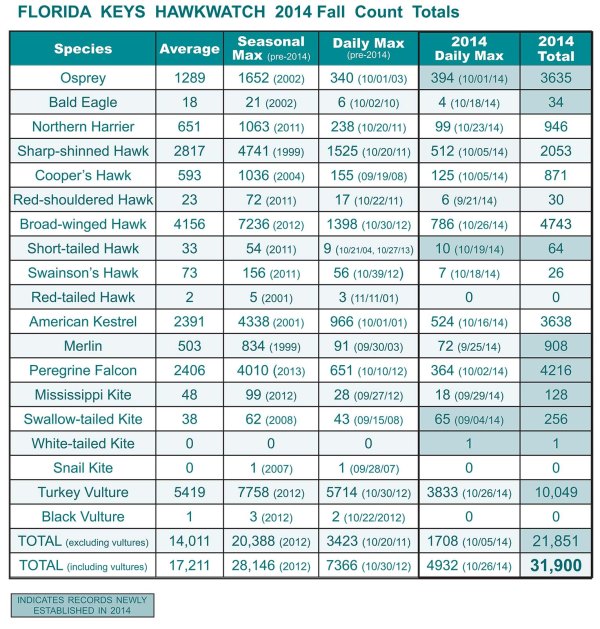
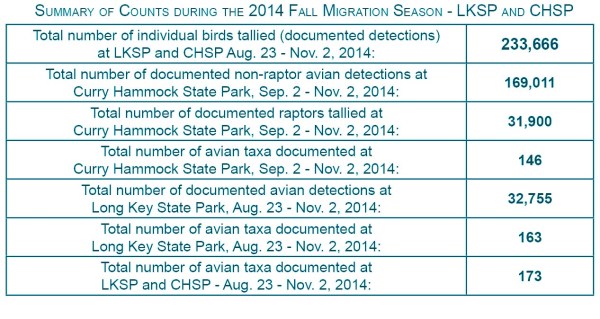

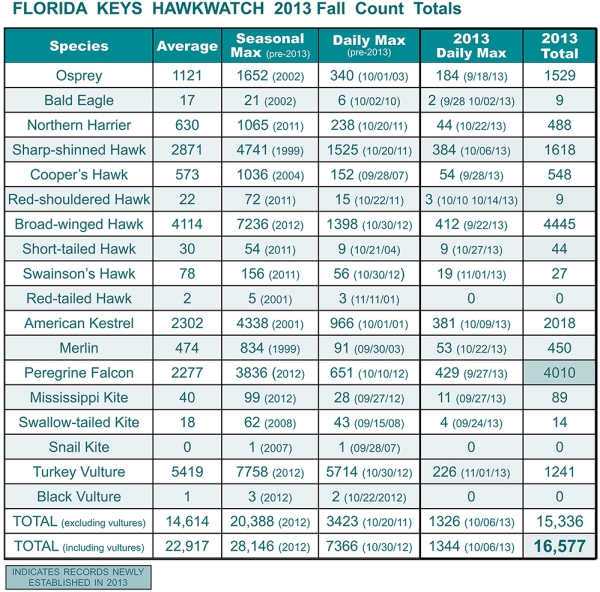











Thanks for a truly wonderful experience! It was great to meet Rafael, Jim, and Jeff and to help with the tail-end of your count. I’ll never forget my best birding to date.
All the best,
Mike Boyd